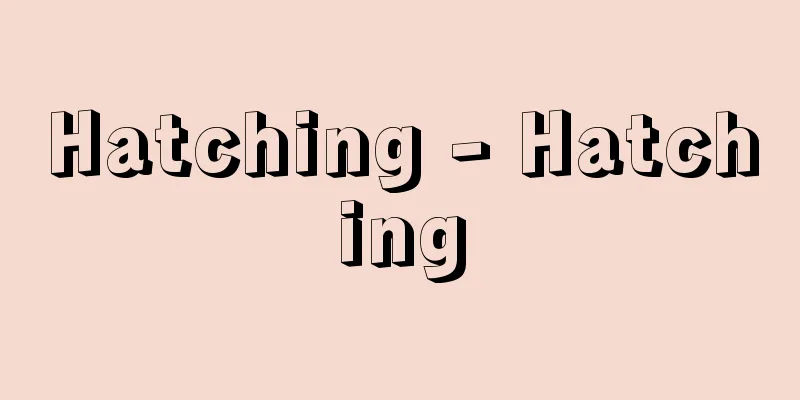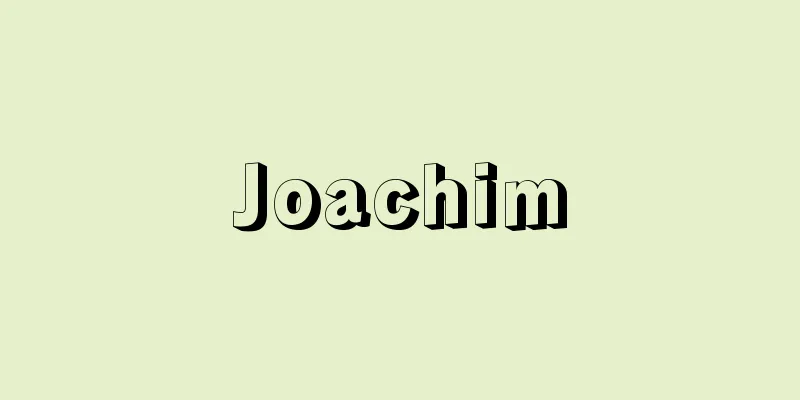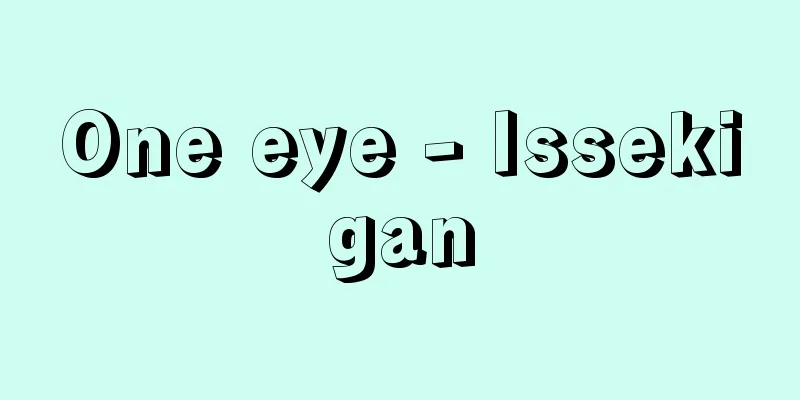Hatching - Hatching

|
The process by which an animal's embryo or larva, which has developed within the egg membrane, breaks through the membrane and emerges into the outside world. Hatching also occurs in viviparous mammals, but generally refers to oviparous and ovoviviparous animals. Hatching can be achieved by mechanically breaking the egg membrane or shell, or by chemically dissolving it, or by both. Mechanical methods include bending and stretching the body, and monotremes (platypuses, echidnas), birds, and reptiles have hard protrusions called egg teeth that form on the tip of their beaks or mouths, and many insects have hard protrusions around the head and mouths, which are used to peck or apply pressure to break the shell. The egg teeth degenerate after hatching. Chemical methods are seen in amphibians, fish, and some invertebrates (sea urchins, sea squirts, squids, some grasshoppers, etc.). The embryo secretes a specific enzyme (hatching enzyme) that digests and dissolves the egg membrane from the inside, allowing it to hatch. This enzyme is a proteolytic enzyme, and it easily dissolves even stable egg membranes. Hatching occurs in a fairly short time. In medaka, it takes about 30 minutes to an hour. As hatching approaches, the embryo's breathing rate increases suddenly, and this is said to trigger hatching. The developmental stage at which hatching occurs varies depending on the animal. In sea urchins, it occurs at the early blastula stage, while in insects and frogs, the embryo hatches as a larva, in fish as a larva, and in birds as a chick, and the organs are in an advanced state of differentiation. Artificial incubation refers to the hatching of livestock eggs, fish eggs, silkworm eggs, etc. using human labor for developmental experiments or industrialization. [Keiichi Onoyama] Hatching in poultryThe time required for poultry to hatch varies by species, and even within the same species, depending on the conditions prior to incubation. In chickens, it takes about 10 hours from when the embryo starts to hatch until it finishes. Chicks that hatch too late are often weak. When breaking the eggshell, special hatching muscles develop in the neck of the chicken embryo, and a hard egg tooth appears above the snout, which is used to peck inside the egg and break the shell. This muscle and egg tooth regress upon hatching. The number of days for incubation varies by species of poultry, and for chickens it is 21 days. In the case of natural incubation, where the parent bird incubates and incubates the eggs, they keep them warm using their body heat, occasionally shifting their bodies while incubating, moistening the eggs with morning dew to keep them humid and preventing them from drying out, and moving their wings to ventilate the eggs expels carbon dioxide and supplies oxygen, ensuring successful hatching. In the case of artificial incubation, in which a large number of hatching eggs are hatched at an egg hatchery, an incubator is used to artificially create conditions that are the same as those for natural incubation. [Nishida Tomoko] [Reference] |Source: Shogakukan Encyclopedia Nipponica About Encyclopedia Nipponica Information | Legend |
|
卵膜中で発生が進んだ動物の胚(はい)または幼生が卵膜を破って外界に出ること。胎生の哺乳(ほにゅう)類でも孵化は行われるが、一般には卵生と卵胎生の動物についていう。孵化には、機械的に卵膜や卵殻を破る方法と化学的に溶かす方法があるが、両方によるものもある。機械的な方法としては、体の屈伸運動によるほかに、単孔類(カモノハシ、ハリモグラ)、鳥類、爬虫(はちゅう)類では嘴(くちばし)や口の先端に、多くの昆虫類では頭や口の周りなどに、孵化のすこし前に卵歯(らんし)という堅い突起ができて、これでつついたり圧力をかけて、殻を壊す。卵歯は孵化後に退化する。化学的な方法は、両生類、魚類、ある種の無脊椎(せきつい)動物(ウニ、ホヤ、イカ、ある種のバッタなど)にみられる。胚は特異的な酵素(孵化酵素)を分泌して卵膜を内側から消化して溶かし、孵化する。この酵素はタンパク質分解酵素であり、安定な卵膜も容易に溶ける。孵化はかなり短時間で行われる。メダカでは30分から1時間ぐらいである。孵化に近づくと胚の呼吸量が急に増えるので、これが孵化の引き金になっているといわれる。孵化がどの発生段階でおこるかは、動物によって違っている。ウニは早い段階の胞胚期でおこり、昆虫やカエルは幼生で、魚類は仔魚(しぎょ)で、鳥類は雛(ひな)で孵化し、器官の分化が進んだ状態になっている。 なお、家畜の卵、魚卵、蚕卵などを発生実験や産業化のために人力を加えて孵化させることを、人工孵化という。 [小野山敬一] 家禽における孵化家禽(かきん)では孵化に要する時間は種によって、また同一種でも孵卵前の条件によって多少異なる。ニワトリでは胚が孵化し始めてから孵化し終わるまで約10時間を要する。あまり遅れて孵化した雛は弱いものが多い。卵殻を破るときは、鶏胚の頸(けい)部に特別な孵化筋が発達し、また吻(ふん)の上方に堅い卵歯が生じ、これで卵内からつついて卵殻を破る。この筋肉と卵歯は孵化後退化する。孵卵日数は家禽の種によって異なり、ニワトリは21日である。親鳥が抱卵して孵化させる自然孵化の場合は体温で保温し、抱卵中ときどき体をずらして転卵し、朝露などで羽毛をぬらして卵に湿度を与えて乾燥を防ぎ、羽を動かして換気することによって二酸化炭素を排出し、酸素を補給して孵化を成功させる。孵卵場で多数の種卵を孵化させる人工孵化の場合は、孵卵器を用いて人為的に自然孵化と同じ条件をつくりだして孵化させる。 [西田恂子] [参照項目] |出典 小学館 日本大百科全書(ニッポニカ)日本大百科全書(ニッポニカ)について 情報 | 凡例 |
<<: Fugue - fuga (English spelling) Italian
Recommend
Proszynski, K.
…Film production in Poland began in 1902 when a y...
Treasury Account Book - Money Treasury Account Book
…In the Edo period, tax and other accounting book...
Kyoto magistrate - Kyoto Machibugyo
A title of a position in the Edo Shogunate. One o...
Counterfeiting of currency - counterfeiting
Crimes that undermine public confidence in curren...
Hamakitajin - Hamakitajin
These fossil human bones were discovered in a cave...
yatra (English spelling)
…In addition, a genre called muhūrta was establis...
Suspension of civil rights
Civil rights are generally defined as the suspensi...
Dungeness crab - Ginkgo crab
This crab belongs to the family Dungeness, order ...
Eunuchoidism
In particular, he granted the right of succession...
Neutral evolution theory
A theory of molecular evolution proposed by Kimura...
World Trade Organization
The WTO is an international organization whose es...
Hikosan Gongen Seisuke Sword - Hikosan Gongen nearby sword
Joruri Gidayu (Japanese traditional puppet theatr...
Uranine - Uranin
…A type of yellow acid dye that has a carboxylic ...
Single Principle of Accounting - Kaikeitan Itsunogensoku
… [Accounting Category] In order to make it easie...
Hanging fish
〘Noun〙 (From the absence of the glottal stop "...







![Garda [Lake] - Garda](/upload/images/67cb4402bc1f1.webp)

